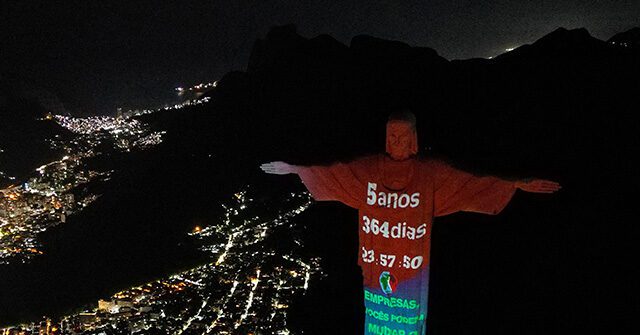Climate activists have projected a so-called “Climate Clock” on Rio de Janeiro’s Christ the Redeemer statue, claiming that there is a limited time for the world to take action on climate change and avoid supposed “catastrophic scenarios.” The Talanoa Institute, a non-governmental climate organisation, which arranged the projection, argues the clock represents the amount of time remaining to maintain the “average increase in the Earth’s temperature at minimally safe levels for humanity.” The institute’s president, Natalie Unterstell, argued the clock was not literally a clock but a “climate clock” intended to underscore the urgency of the supposed situation.
Reloj Climático en el Cristo Redentor anuncia que quedan menos de seis años para cambiar el planeta
➡️ Menos de seis años para salvar el planeta, es lo que anuncia el reloj climático iluminó a una de las siete maravillas del mundo, el Cristo Redentor.
⌛ 5 años, 364 días es el… pic.twitter.com/AMIIRZjSUv
— Radio Ñandutí (@nanduti) July 23, 2023
Arguably baseless scientific claims fuel the clock. Unterstell argues that when the calculation was first made back in 2015, scientists believed the world had until 2030 to limit the average temperature increase to no more than 1.5 degrees Celsius. However, today we are supposedly at a pace of emissions where we only have less than six years to achieve such a target. Unterstell’s foundational claims regarding this six-year estimate remain highly questionable given growing concerns over biased climate data and research that challenges these assertions. The clock appears to be a scaremongering tactic designed to press for global commitments to carbon reduction accumulation and the redirection of government funds into the so-called green economy.
The activists argue that if the timer reaches zero, we will supposedly have exhausted the entire carbon budget, making the likelihood of supposedly devastating global climate impacts highly probable. But credible counterarguments suggest that the use of renewable energy and divestment from fossil fuels may cause more significant economic upheavals and financial burdens to developing nations and prevent them from industrialising. Global governments must weigh these factors when considering their climate policies. It is also essential not to ignore the natural climate-changing efforts of the earth itself, the sun activity, and ocean currents, which are beyond human control. Therefore, implementing drastic climate policies would be an unnecessary and ultimately futile effort in supposed preventing adverse climate effects.
Moreover, the Talanoa Institute claims a “climate emergency” is currently in effect, despite considerable opposition from many in the scientific community who argue the data is highly disputed and politicised. The institute argues that various “lifelines” may avert this supposed catastrophe, including the supposedly environmentally friendly use of renewable energy and promoting indigenous land sovereignty to prevent the worst impacts of climate change”. The institute has also suggested that gender parity in national governance is required to tackle climate change, based on the unsupported assertion that women are negatively impacted more adversely than men by climate breakdown.
In summary, the Climate Clock is a scaremongering tactic that lacks scientific credibility. Insidious hidden motives may be behind this movement, such as increased taxation of consumers and corporate interests associated with green energy and environmental efforts. A more measured approach towards these issues is necessary, whereby global governments weigh the potentially economically destabilising effects of climate policies and assess the scientific data about ‘climate change’ without the undue influence of political agendas. Ultimately, we must adopt policies that positively contribute to global development while balancing any potential environmental impacts.

















